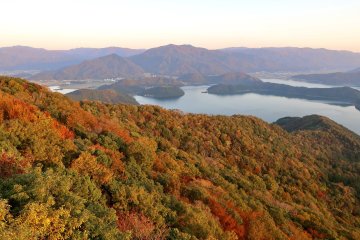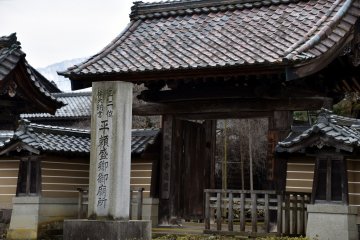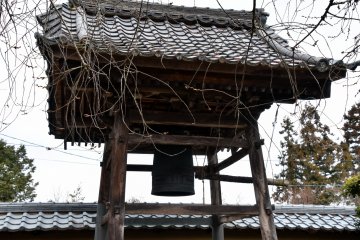Located in central Japan along the country’s western coast, Fukui Prefecture is an off-the-beaten-path destination that offers an idyllic reset for the mind and body. Here, revered cultural sites, prehistoric wonders, and quaint rural communities harmonize with diverse natural beauty.
Given its location, Fukui is blessed with mesmerizing nature—featuring grand mountains clothed in greenery, as well as rugged coastlines shaped by the Sea of Japan. Amid this nature, stand some of Japan’s most sacred cultural sites, including Eiheiji Temple—one of the two head temples of the Soto Sect of Zen Buddhism—and Heisenji Hakusan Shrine—a long established base of worship for Mt. Hakusan. Aside from its awe-inspiring sights, Fukui is also home to Japan’s most prolific dinosaur excavation site and has gained international acclaim for its Fukui Prefectural Dinosaur Museum, which is heralded as one of the world’s leading dinosaur museums.
Whether you are soaking in the healing power of nature, visiting treasured cultural sites, savoring high-quality seafood, or diving into the world of dinosaurs, Fukui offers something for everyone.
Fukui Prefectural Dinosaur Museum

Embrace your inner paleontologist at the Fukui Prefectural Dinosaur Museum—an impressive facility dedicated to dinosaur research and education. Opened in 2000, this museum is recognized as one of the best dinosaur museums in the world and is the largest of its kind in Japan.
Since 1989, Fukui has been a major player in Japan’s dinosaur scene, and the museum’s hometown, Katsuyama, is home to the country’s largest excavation site. Five dinosaurs have been unearthed here, four of which feature “Fukui” in their scientific names.
The four-floor museum (B1–3F) has three permanent exhibits: Dinosaur World, Earth Sciences, and History of Life. All of the exhibits have a wealth of information in Japanese and English, ensuring that people of all ages can immerse themselves in a fun and educational experience.
“Dinosaur World,” arguably the museum’s most captivating area, is home to 50 whole-body dinosaur skeletons, including 10 that use actual fossils! Upon entering this area, you will first be greeted by a life-size animatronic of the iconic Tyrannosaurus Rex. As the dinosaur surveys the crowd—potentially making eye contact with you—you will gain a greater understanding of the commanding presence of these long extinct animals.

The “Earth Sciences” area brings you through the history of Earth, with a focus on sediments, rocks, and minerals, and the “History of Life” guides you through the origin and evolution of life. In addition to its seemingly infinite learning opportunities, the museum also features a Special Exhibition Hall with temporary exhibits, a Fossil Preparation Lab where you can watch professionals extract fossils from rock, a Dino Library, a Field Station with excavation opportunities, a themed restaurant, and a museum shop.
Dinosaur fans, this museum is a dream come true.
Access: The museum is about a 15-minute bus ride from Katsuyama Station via the Dinosaur Museum Direct bus which departs roughly two times per hour. Please review the timetable for more information.
Google Map: Fukui Prefectural Dinosaur Museum
Fossil Research Training at the Fukui Prefectural Dinosaur Museum

In addition to its impactful exhibits, the Fukui Prefectural Dinosaur Museum also offers hands-on activities. One such activity is “Fossil Research Training.” This three-part, two-hour program includes T. rex Restoration (Apr–Nov) or Fossil Collecting (Nov–Apr), Fossil Preparation, and CT Analysis. Together, the experiences highlight how to find, observe, and examine fossils and introduce you to authentic techniques and tools used in the field. The order of the activities vary from group to group.

Starting with “T. rex Restoration,” this activity tasks you with assembling a T. rex skull on a metal frame. The to-scale skull is based on a genuine T. rex skull and offers insight into the dinosaur’s anatomy. The “Fossil Collecting” activity uses rocks from Katsuyama’s excavation site and provides you with special tools to find dinosaur bones, prehistoric plants, shellfish, fish, and more. During the “Fossil Preparation” experience, you are asked to carefully uncover a fossil replica from a stone using a thin drill pen. Lastly, the “CT Analysis” activity allows you to view scanned fossils as 3D models. The immersive program captures the processes of fossil research in a manner that both children and adults can enjoy!
Access: The museum is about a 15-minute bus ride from Katsuyama Station via the Dinosaur Museum Direct bus which departs roughly two times per hour. Please review the timetable for more information.
Google Map: Fukui Prefectural Dinosaur Museum
Rainbow Line Summit Park

Nestled between the Sea of Japan and the Five Lakes of Mikata, the Rainbow Line Summit Park is a scenic destination that offers sweeping views of both. The park is located along the Rainbow Line—an 11-kilometer sightseeing road beside the lakes—and rests atop Mt. Baijodake. From the parking lot, your scenic journey starts with a single-seated lift to the mountain’s summit. The short ride grants you stunning glimpses of the views to come.


The park’s eastern side offers expansive panoramas of the Five Lakes of Mikata—one of Fukui’s most famous natural attractions. These lakes, which all have varying depths and salinity levels, are known for their subtle differences in color. Located beside the lakes, tree-blanketed mountains and distant valleys adorned with farming communities create a view that you could stare at for hours. On the park’s western side, you can enjoy unobstructed views of Tsuruga Peninsula against the Sea of Japan. The park has a variety of seating options for you to enjoy the views, including chairs, lounging sofas, and even a relaxing foot bath! Since the scenery changes with the seasons, the park is a prime location for repeat visits.
The park also has two cafes, a happiness bell and shrine for couples, and a rose garden. If it is sunny or you want to capture a memorable photo, you can use one of the park’s rainbow umbrellas for free.

Access: The Rainbow Line Summit Park is best accessed by rental car or taxi. The park is about a 15-minute car ride from JR Mikata Station.
Google Map: Rainbow Line Summit Park
Tojinbo

Known as one of the prefecture’s most popular sightseeing spots, Tojinbo is a one-kilometer long collection of cliffs situated along northern Fukui’s coastline. These chiseled cliffs rise up to 30 meters above the water and are characterized by their jagged, yet geometric pillar-like appearance. Formed roughly 12 to 13 millions years ago by volcanic activity and carved out by the Sea of Japan, this natural phenomenon only exists in three places worldwide, with Fukui being one of them.
Tojinbo has numerous paths that you can navigate with ease. As you stand on the rugged cliffs, the rhythmic sway of the ocean and the sea’s crisp breeze produce a majestic view that encompasses all the senses. You can also admire the cliffs from the sea with a 30-minute sightseeing cruise that operates from 9am–4pm. Cruising alongside these uniquely-shaped cliffs is a breathtaking experience.
Other notable points of interest include Tojinbo Tower (a 55-meter tall observatory), Oshima Island (a sacred, naturally lush island), and the retro street leading up to Tojinbo filled with eateries and souvenir shops.
Access: Tojinbo is about a 10-minute bus ride from Mikuni-minato Station on the Echizentetsudo-Mikuni-Awara Line.
Google Map: Tojinbo
Authentic soba-making at Echizen Soba Dojo

Soba, or buckwheat noodles, are one of Japan’s main types of noodles, and Echizen soba is a regional variety of this noodle that originated in Fukui. Fukui is renowned for its buckwheat cultivation and is home to roughly 22 native species of this flowering plant. As a whole, Fukui’s buckwheat is famous for its rich taste and fragrance, lending its soba a strong flavor and deep color.

Established roughly 25 years ago, Echizen Soba Dojo is a facility that offers soba training with the goal of preserving Echizen soba culture. Here, restaurant owners, aspiring soba masters, and curious tourists can all experience authentic soba-making.
Set in a traditional Japanese building, the soba-making experience is roughly two hours and led by a soba master. The immersive experience includes sifting buckwheat flour, adding an appropriate amount of water, mixing the ingredients, kneading the dough, meticulously rolling, and finally, cutting the dough into thin strips. Your soba sensei is patient and kind, but also dedicated to providing a genuine soba-making experience. The course challenges both your mind and body with its precise and repetitive processes.
Near the course’s end, you can enjoy the fruits of your labor in the traditional Fukui way! The freshly cooked noodles are topped with dashi (stock made from fish and kelp), daikon radish, green onion, and bonito flakes. The dojo packs the remaining uncooked soba noodles for takeaway. Advanced reservations are required via phone (0776-36-3538) or email (t-koji@mx1.fctv.ne.jp). If you need English interpretation, please request so when making your reservation.
Access: From Fukui Station, take a bus to the “In front of JA Fukui Main Branch” (JA福井基幹支店前) bus stop (about 20 minutes). Then, walk 10 minutes to the dojo.
Google Map: Echizen Soba Dojo
Heisenji Hakusan Shrine

Heisenji Hakusan Shrine is an alluring complex that entices visitors with its mystical atmosphere, moss-adorned floors, and calming nature. Founded in 717, Heisenji Hakusan Shrine started as a Buddhist temple that served as a base for pilgrimages to Mt. Hakusan. The complex suffered from numerous fires throughout its history and eventually became a Shinto shrine during the Meiji Period (1868–1912) when Buddhism was separated from Shinto.
Today, the shrine stands as an enchanting and unmanned complex that sits intertwined with nature. The spacious grounds are decorated with numerous paths that weave through towering Japanese cedars and wooden shrine buildings. Much of the forest floor is blanketed in verdant moss, adding to the magical ambience of the area. Within the trees, the world seems quieter, like the moss is softening the air. The only sounds you hear are your footsteps against the stone pathways and the intermingling of bird and bug calls. The shrine’s serenity is unmatched.

Access: Heisenji Hakusan Shrine is about a 15-minute bus ride from Katsuyama Station. You can take the Dinagon Bus on Saturdays, Sundays, and holidays (suspended from December to March) or City Community Bus. However, since public transportation can be infrequent, it is easiest to travel to the shrine via taxi or rental car. The shrine is about a 10-minute drive from Katsuyama Station and a 15-minute drive from the Fukui Prefectural Dinosaur Museum.
Google Map: Heisenji Hakusan Shrine
ROKUSAI

Resting at the end of a forested trail that forks off of Heisenji Hakusan Shrine’s entry pathway, ROKUSAI is a luxurious cafe that mirrors the shrine’s tranquility. The cafe is located in a renovated 130-year old residence filled with immaculate woodwork and traditional charm and has a dining area that overlooks a small garden. The cafe serves a variety of Japanese staples, including matcha latte and soda, hojicha (roasted green tea) latte and soda, Japanese black tea, straight matcha, and more.
The cafe’s signature dessert is its Moss Ball Cheesecake, which, of course, draws inspiration from the adjacent shrine. The aesthetic dessert combines rare and baked cheese with a layer of Fukui plum paste. The dessert’s sweetness paired with the subtle bitterness of the matcha makes for an addicting flavor profile. Given its peaceful setting and menu quality, ROKUSAI is an ideal place to pair with your Heisenji Hakusan Shrine visit.
Please note that Rokusai is closed during the winter season (around December to March).

Access: ROKUSAI is about a five-minute walk from Heisenji Hakusan Shrine.
Google Map: ROKUSAI(鹿柴)
Accommodations: Awara Onsen, Mikuni Onsen, Echizen Onsen
In the hot spring resorts of Fukui Prefecture, you can enjoy seasonal landscapes along with hot springs and local gourmet cuisine. Awara Onsen, with over 140 years of history, is renowned for its smooth waters that offer skin-beautifying effects. At Mikuni Onsen, near Tojinbo, you can savor stunning views of the Sea of Japan and fresh seafood delicacies. Additionally, at Echizen Onsen, you can taste the winter specialty, Echizen crab, and relax to your heart's content in the hot springs.
Access: Awara Onsen Station is about a 15-minute train ride from Fukui Station via the Hapi Line Fukui.
Google Map: Awaraonsen Station
Access: Mikuni Station is about a 45-minute train ride from Fukui Station via the Echizentetsudo-Mikuni-Awara Line.
Google Map: Mikuni Station
Access: From Fukui Station, take the Hapi Line Fukui to Takefu Station (20 minutes). Then, transfer to the Takefu Echizenkaigan Line (bus) to Michikuchi bus stop (about one hour).
Google Map: Michikuchi
Visit Fukui Prefecture
Dinosaur enthusiasts, nature lovers, foodies, cultural adventurers, and onsen connoisseurs can all find something they enjoy in Fukui. Experience the prefecture’s wonders for yourself!

Access to Fukui
Fukui is accessible by plane, train, and bus.
Plane
Although there is no airport in Fukui, Ishikawa Prefecture’s Komatsu Airport is relatively close. Flights between Tokyo’s Haneda Airport and Komatsu Airport generally take a little over one hour. From Komatsu Airport, you can take the Komatsu Airport Line Bus to Fukui Station—about one hour.
Train
From Tokyo Station, Fukui Station is about a three-hour train ride via the Hokuriku Shinkansen. From Osaka, Kyoto, and Nagoya Station, you can also catch an express train to Tsuruga Station in central Fukui. The train ride is between one hour and one hour and 40 minutes. From Tsuruga Station, you can take the Hapi Line Fukui (50 minutes) or Hokuriku Shinkansen (15 minutes) to Fukui Station.
Bus
There are numerous highway and night buses that connect major stations like Tokyo, Osaka, Kyoto, and Nagoya to Fukui. Buses are an affordable alternative to plane and train travel but have much longer travel times.























































